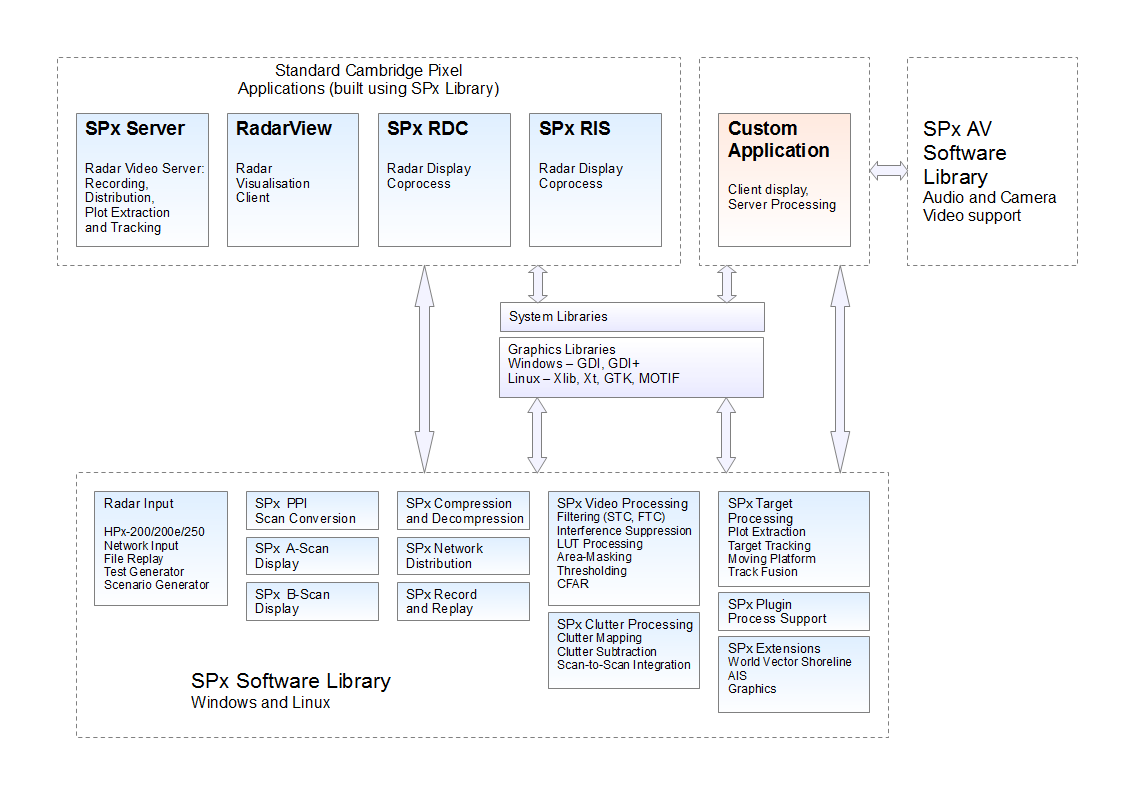SPx provides a software library based on a set of C++ classes and pre-built servers. You can use the capabilities you need by simply creating objects and linking them with your application code. SPx supports client-server configurations or "integrated" applications with all capability contained in a single executable. See here for SPx Programming information.
SPx provides both radar compression and decompression components that employ algorithms specifically designed for radar video. Careful attention is paid to preserving signal quality and minimising latency for network distribution. The module is fully parameterised and is easily incorporated into a C/C++ based application program, or simply built with other SPx components as needed. Like all other SPx modules, your application remains in control.
SPx provides radar processing capabilities including clutter processing, plot extraction and target tracking. The software is fully parameterised, allowing you to customise its behaviour to meet your exact requirements. It is also extensible, allowing you to use the capabilities that you need, and adding your own special processing if preferred. Acquire only the modules you need and enhance as desired. SPx-Scan provides a set of high-performance radar scan-conversion modules that create PPI, A-Scan or B-Scan displays (display formats explained here) with industry-standard graphics hardware. SPx-Scan may be used stand-alone or combined with any of the other SPx modules for a complete acquisition and display chain. The SPx-Scan scan-converter supports multiple windows, multiple radars and provides superior quality displays using industry-standard computing components. SPx-Scan is easy to incorporate into a display application, optionally using other SPx modules to deliver the radar video, or using your own hardware and software where that exists.
SPx is supplied as one or more software modules with well-defined inputs, outputs and control parameters. You can easily add SPx modules into your C/C++ application, adding only the capabilities that you need. Multiple SPx modules can be used by linking them through an SPx Manager that takes responsibility for connecting the output of one module to the input of the next. Your application still gets control of the parameters of each SPx module, where you need it, and you can even add your own modules into the chain if you wish to pre-process the data or add your own capabilities. SPx is unique because it keeps you in control. If you eventually need to enhance or upgrade the functions of an SPx module you can simply drop in a form-fit function replacement, without affecting the rest of the system.

Summary of benefits:
· · Low-cost, industry-standard processing hardware
· · Exploits the capabilities of modern multi-core processors and graphics processors
· · Provides high-performance radar processing and display with cost-effective, easily-maintained hardware platforms
· · Extensible and flexible software architecture
· · Based on open standards and the principles of open architecture
· · Open-standard network protocols and open standard radar compression and distribution
Summary of features:
· · Modular, flexible and configurable
· · Software Scan Conversion (PPI, A-Scan, B-Scan)
· · Radar Processing library
· · Radar video compression and network distribution
· · Plot Extraction and Target Tracking
· · Clutter Processing
· · Track Fusion
· · Radar recording and replay
· · Auto compositing of radar with existing graphics
· · Windows and Linux/X11 options